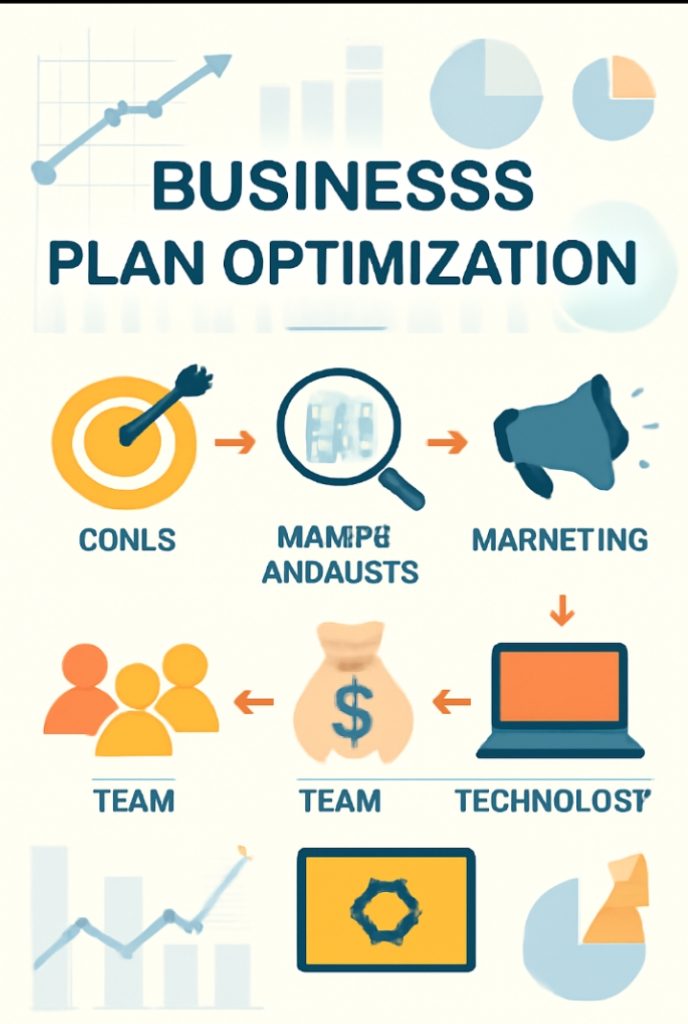
Introduction:
Every successful business starts with a perfect Business Plan, but not every business plan is designed to thrive in today’s evolving marketplace. If your goal is to move beyond survival and enter the realm of rapid, scalable growth, optimizing your business plan is critical. A growth-focused business plan is not a static document; it’s a living blueprint designed to adapt and scale with your company’s ambitions. In this post, we’ll break down proven tactics and strategies to upgrade your plan for growth, covering everything from market analysis to performance metrics, funding strategies, and the power of technology and team alignment. Whether you’re a startup founder, a small business owner, or scaling a tech venture, these actionable steps will set your business on a clear path to sustained expansion and profitability.
Why Optimization Matters
Optimizing your business plan isn’t just about impressing potential investors or ticking boxes for a bank loan. It’s about crafting a document and a mindset that continually drives your business forward. An optimized plan:
Keeps your team aligned and focused on clear objectives.
Equips you to identify opportunities and swiftly respond to market shifts.
Attracts funding and strategic partners.
Enables systematic, measurable scaling
1. Set Clear, Ambitious but Achievable Goals
Every growth oriented business plan starts with clear objectives. Your goals should be specific, measurable, attainable, relevant, and time-bound (SMART). Good growth goals answer:
How much do we want to grow? (Revenue, customers, market share)
By when? (Set quarterly and annual targets)
What are the critical milestones?
2. Conduct a Growth-Driven Market Analysis
Market analysis should do more than describe the present; it should highlight where accelerated growth is possible:
Identify trends: Use data and AI tools to spot emerging opportunities in your market.
Assess competitors: Look for gaps or weaknesses where your business can stand out.
Understand the customer: Dive deep into evolving customer needs and how your offering solves new or future problems.
Pro tip: Use free market research templates to speed up this process.
3. Build Agility into Your Business Model
Rigid business models stifle growth. Instead, optimize your plan by:
Designing your revenue streams to allow for pivoting or scaling up.
Including contingency plans for potential roadblocks.
Outlining partnerships, distribution channels, or tech solutions that can drive fast expansion.
4. Detail a Robust Marketing & Sales Strategy
Growth depends on reaching new customers and converting them efficiently. Your business plan should define:
Target customer profiles (personas)
Scalable marketing channels (digital, content, SEO)
Sales funnel optimization for higher conversions
Referral and upsell strategiesUse AI-powered tools for campaign automation and data-driven insights.
5. Optimize Financial Projections for Growth
Growth eats capital. Your plan should:
Forecast cash flow under multiple growth scenarios, including best and worst cases.
Outline investment needs and planned usage of funds (technology, hiring, marketing).
Prepare financial dashboards for real-time tracking of KPIs.
Consider making projections visually appealing with easy-to-edit templates in Google Docs or Canva.
6. Align Your Team and Culture
A business can only grow as fast as its people. Your plan should include:
Key hires needed to reach your goals.
Training and development strategies.
A growth-oriented company culture that rewards innovation and results.
7. Incorporate Technology for Scalability
Technology shifts are central to growth. Consider:
Automation tools for marketing, sales and operations.
CRM systems to manage scaling customer relationships.
Cloud-based project management to maintain agility.
8. Define Growth KPIs and a Feedback Loop
Your optimized plan should outline key performance indicators and regular review cycles:
Define what “growth” means for your business (users, MRR, market share).
Set up regular checkpoints: Monthly or quarterly reviews.
Use dashboards for real-time updates.
Bonus: Use Editable Templates and Visuals
Speed up the optimization process by using editable business planning templates (especially on Google Docs and Canva) ideal for iteration and feedback loops.
Example Illustration of Growth Optimization
A digital marketing startup, after revising its business plan to include scalable service bundles, adopted AI analytics for client campaigns. In six months, it doubled its recurring client base and improved profit margins by streamlining operations and focusing on customer experience.

Conclusion:
Optimizing your business plan for growth is not a one time task it’s a continuous process. By setting clear goals, staying responsive to market shifts, leveraging technology, and keeping your team aligned, you prepare your business to seize opportunities and overcome challenges in an ever-changing landscape. The most successful companies treat their business plan as a living document, iterating often and aligning every decision to a future vision of growth. If you want your business plan to be more than paperwork turn it into your engine for lasting success.